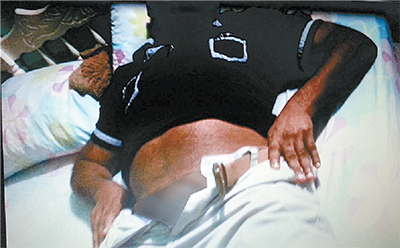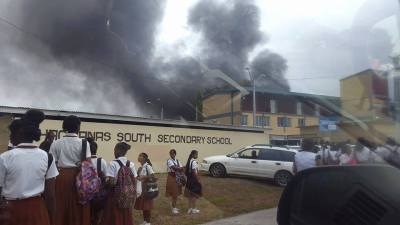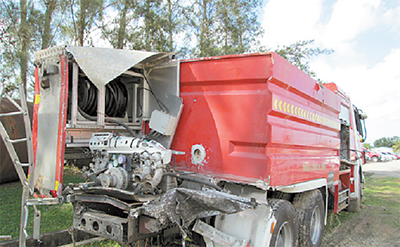Fire is devastating. It hasn’t touched my life, but last weekend reminded me how easily it could.
I currently spend a chunk of each day at a wonderfully staffed new Caura Hospital unit operated jointly by the Palliative Care Society and North-Central Health Authority. It was a complicated decision. Caura is a place of childhood trauma. From the roadway where I now park, I helplessly witnessed my grandmother’s 1960s deterioration from cancer, and its emotional wreckage on the mother I now visit.
 Several evenings, driving home or back up after dinner, I’ve watched the haunting orange glow of unchecked bushfires in the Caura hills. By day, their signature is grey clouds of smoke wafting over the brown-green mountain range, as I climb Royal Rd. past cars of roadside limers.
Several evenings, driving home or back up after dinner, I’ve watched the haunting orange glow of unchecked bushfires in the Caura hills. By day, their signature is grey clouds of smoke wafting over the brown-green mountain range, as I climb Royal Rd. past cars of roadside limers.
May 4th, fires destroyed 75 hectares and thousands of parrot hatchlings in a prime nesting area, making news. On Saturday 16th—an event that didn’t pique the interest of the slow newsrooms I alerted—they spread to a corner of the hospital compound, igniting the grass surrounding a disused building and two others across the road from the campus. Driving out, we watched workers scramble with what looked like a nozzleless garden hose to sprinkle the glowering ground. An alert went up, and they scurried to the rear of the building. Next morning driving in, the same hose was dousing a tree stump that had continued to smoulder and reignited.
It had been a long, tough day, and the likelihood seemed remote our loved one on the other side of the compound would be incinerated or evacuated clumsily down a hillside. But we had a gnawing sense that reliance authorities were in charge was not a wise thing. I called 999, who said their number was only for police emergencies, not fires, disconnecting without giving me a correct one. The 998 fire emergency dispatcher said Tunapuna station was already alerted, and responding.
But in my mind flashed residual memories of months of news reports on the Fire Service, with little confidence.
 The weekend before, fire destroyed two Belmont homes as firefighters failed to reach in time. Fire Association president Leo Ramkissoon (who might be more useful to the nation in a management role) cited over 170 weekend calls to the service due to annual dry-season bushfires. One much like the one we were witnessing had crawled to the Lady Young lookout and closed one lane of the road to rush-hour traffic
The weekend before, fire destroyed two Belmont homes as firefighters failed to reach in time. Fire Association president Leo Ramkissoon (who might be more useful to the nation in a management role) cited over 170 weekend calls to the service due to annual dry-season bushfires. One much like the one we were witnessing had crawled to the Lady Young lookout and closed one lane of the road to rush-hour traffic .
.
The previous time I recall a chief fire officer’s name called was the one National Security Minister Jack Warner insisted had requested Junior Sammy be paid $10.2 million after the company retrieved a damaged six-year-old fire tender purchased for $2.2 million that slid down a Blanchisseuse precipice. Cabinet twice declined to; eventually making a $6.8 million payment—compared to quotes of  $25,000-$50,000 the Guardian received for the job, and the Fire Service Association report of an offer to remove the vehicle for free. Warner said he would pay it again.
$25,000-$50,000 the Guardian received for the job, and the Fire Service Association report of an offer to remove the vehicle for free. Warner said he would pay it again.
This February, unpaid fuel bills threatened fire engine operations. In March, six fire stations were reported to be unresponsive, due to faulty equipment. The same month a photo taken in T&T of an “ultrablinged” Fire Services pick-up truck with copper rims and a fiery paintjob was captioned “Pimp my Firetruck” by a leading Toronto news outlet. This month, two Prado SUVs and a Lexus sedan were commissioned at a Fire Services ceremony. “Acting Chief Fire Officer Roosevelt Bruce said the utility vehicles were bought instead of the fire tenders because they were easier to acquire. He said specialised fire-fighting equipment had to be imported and took months to acquire,” the Guardian newspaper reported.
Unresolved labour issues threatened fire safety operations during Carnival. The union also complained its officers aren’t being allocated established government housing set-asides, while the Partnership embarks on a 500-house lottery and 100-house-a-week giveaway. Union leadership voiced clear support for “total policing.”
This week a 13-year-old is charged in an arson case where students burned down a school building, and a Macoya business went up in flames (though corporate influence ensured a prompt response).
 Firefighting ought to be one area of national security most resilient to politics and bacchanal. Perhaps fittingly, there’s barely any mention of fire in the People’s Partnership 2010 manifesto. In contrast, the PNM’s (interestingly, it’s been taken offline) boasts of three fire stations completed, and promised 12 more. The Fire Service’s website lists 2,700 uniformed fire personnel and 24 stations. A 2013 revised strategic plan aims to achieve a maximum response time of eight minutes to structural fires. But getting current information about recent engine acquisition and station construction proved hard, requiring a call from the Chief himself.
Firefighting ought to be one area of national security most resilient to politics and bacchanal. Perhaps fittingly, there’s barely any mention of fire in the People’s Partnership 2010 manifesto. In contrast, the PNM’s (interestingly, it’s been taken offline) boasts of three fire stations completed, and promised 12 more. The Fire Service’s website lists 2,700 uniformed fire personnel and 24 stations. A 2013 revised strategic plan aims to achieve a maximum response time of eight minutes to structural fires. But getting current information about recent engine acquisition and station construction proved hard, requiring a call from the Chief himself.
 An engine did respond to the hospital fire. Hopeless Westerners (I was only born in Tunapuna), we drove around Eastern Main Rd. looking for the fire station, prepared to do a small performance about patients going up in flames. They explained the delay: the Caura call came in as a bushfire, and there were just three appliances capable of responding—San Juan (down); Tunapuna (out battling a house fire, higher priority); and Arima (out fighting bushfires).
An engine did respond to the hospital fire. Hopeless Westerners (I was only born in Tunapuna), we drove around Eastern Main Rd. looking for the fire station, prepared to do a small performance about patients going up in flames. They explained the delay: the Caura call came in as a bushfire, and there were just three appliances capable of responding—San Juan (down); Tunapuna (out battling a house fire, higher priority); and Arima (out fighting bushfires).
I’ll be looking out for fire preparedness commitments in the 2015 manifestos.

